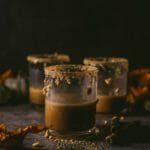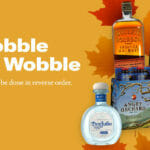Single Malt and Blended Scotch 101
The single malt vs. blended scotch debate is still a hot topic. Single malt enthusiasts will argue that the drinks are superior to blended scotch. And of course, proponents of the beloved blended scotch will have to disagree.
So what’s the big deal? Single malts make up a percentage of blended scotch anyway, so aren’t they essentially the same thing?
Not exactly. If you have a specific flavor profile you’re thirsting after, for example, then you’ll have to know the difference between single malt and blended scotch.
Being a complete novice in the whiskey world can be daunting. So here is some insight that can act as a compass to help you navigate the amber waves of the Scotch Sea.
What is the difference between single malts and blended scotch?
Single malts vary from blended scotch in flavor profiles, availability, popularity, and the distilling process. The one you decide to drink depends heavily on what your preferences are.
Do you like to feel like everything you consume is one-of-a-kind? Or are you more of a tried-and-true type of person? Do pungent flavors make you drool? Or do you like a smooth, mellow profile?
Let’s explore the basics of each to get a better understanding.
Single Malts
To be a single malt, the whiskey, made from barley, has to be made at a single distillery. This means that a Glenlivet single malt whisky will only see the inside of a Glenlivet distillery during production.
But if you’re scoping out a single malt thinking it comes from a single barrel or cask, you might have to dig a little deeper than expected. Most single malts come from a ton of barrels and casks that have been blended together. These all have different ages, but only the youngest is represented on the bottle.
For example, a 16-year-old whisky means the youngest whisky in the bottle is 16 years old. However, that Aberlour may contain whisky a lot older than that.
But as is the case of siblings, the youngest is the star of the show.
Blended Scotch
Blended scotch combines grain whiskey generally from 60% to 80%, and barrel-aged malt whisky in multiple barrels and casks. Single malts only use barely, while blended scotch can use a mixture of corn, rye, and wheat as their base. All these grains add to the diversity of this drink’s flavor profile.
Blended scotch doesn’t have to be produced at just one distillery like single malts. This means that over 30 single malts might be included in a single blended scotch!
All of the blended whiskies have to be aged for a minimum of three years before they can be called a Scotch Whisky, though. Sorry, new blended whisky. You’re not old enough to enter the cool kids club just yet.
What is the aging process for whiskey?
Wondering if either of these will age like fine wine in the bottle? They won’t.
If you buy a bottle of scotch that is 15 years old, it will stay 15-years-old even after 100 years if it’s unopened and kept out of direct sunlight. If only this were the anti-aging secret for humans.
So, what’s the deal with the snobbery surrounding single malts? Are they really better than blended scotch? Which is more preferred around the world? Let’s find out.
Is single malt whiskey or blended scotch more popular worldwide?
Single malts are increasing in popularity in the United States, with sales being up 134 percent since ’02.
They exude exoticness and sophistication. The Daily Beast states that consumers tend to think that single malts are more valuable because they believe they’re rarer.
Single malt elitists feel special when they drink this rare scotch. It’s kind of like getting to buy a rare square watermelon in Japan. Or eating caviar in an upscale, luxurious restaurant in Paris.
But exclusivity doesn’t always mean a product is more popular or sought after.
Although sales for single malt scotch is up, they still don’t outnumber those of blended scotch sales. According to the stats, blended scotch consists of more than 80 percent of all the scotch sold within the U.S. This comes out to 7.8 million cases being purchased per year.
Blended scotch is highly favored globally as well. In Asia and Latin America, it has been gaining popularity over the years, becoming a common favorite among whisky drinkers.
So, it’s fair to say that blended scotch still beats single malts by a long shot in the popularity category despite the V.I.P appeal of its competitor.
For the Cutty Shark to end up on Forbes’ list for “The World’s Best Scotch Whisky,” according to the 2020 New York International Spirits Competition, blended scotch must be doing something right.
Whiskey flavor profiles
If you’re a wine connoisseur, you know that before taste comes before the smell. This is also the case with scotch.
Ali Reynolds, Johnnie Walker‘s whisky ambassador, told Business Insider, if the whisky has a bit of sting to it, it’s likely a young whisky. The presence of other flavors likely means that it’s a more expensive whisky.
On to the tasting!
The goal of single malts and blended scotch when it comes to taste is quite different. The objective of a single malt is to personify the distillery’s particular style. Single malts will therefore have very distinctive, in-your-face flavors.
The goal of blended scotch is to allow many styles of whiskey to seamlessly merge together and complement one another. These will have a smoother taste. You might have to swish it around in your glass for a moment, stroke your chin, and say “hmmm” a few times before figuring out the flavors.
When it comes down to actual flavor, scotch, in general, tastes oaky and woody. It can also have nutty notes, or caramel, or vanilla notes. Single malts amplify these flavors while keeping the drink smooth and enjoyable.
Blended scotch has rich and deep flavors like chocolate or butter. And since it contains single malts, it also has the notes of fruit and vanilla mixed in. These notes can come from the oak barrels during processing as well in both single malts and blended scotch. Even though this drink can have up to 30 different single malts, only three to six of them make up the core flavor.
Conclusion
Single malts are made at a single distillery and oftentimes contain other single malts as well. To get an even more exclusive feeling, you can find a distillery that offers single malts that all have separate casks.
Of course, this will be more costly, but it’s the price you pay for such an elite experience.
Single malts stand out with fruity flavors with no anonymity. The distinctive taste will always be apparent on your tastebuds.
Blended scotch has been a popular choice of scotch for longer than single malts and continues to be this way. They offer more savory flavor profiles that effortlessly blend together, creating a smooth taste.
Blended scotch may not have the exotic appeal of single malts, but they are definitely a tried-and-true drink all over the world.
With all this knowledge of scotch, you’re probably thirsting for a glass (or two) right about now. Luckily, you’ll be able to choose the best one for you, or at the very least, be able to hold a lengthy conversation about single malts and blended scotch.


